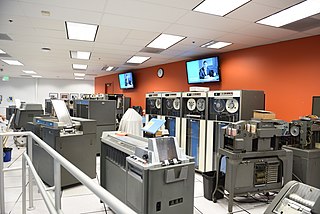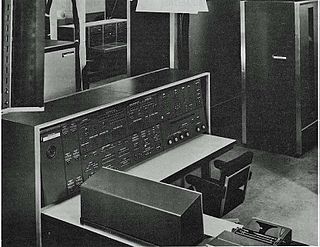
Punched tape or perforated paper tape is a form of data storage device that consists of a long strip of paper through which small holes are punched. It was developed from and was subsequently used alongside punched cards, the difference being that the tape is continuous.
BINAC was an early electronic computer designed for Northrop Aircraft Company by the Eckert–Mauchly Computer Corporation (EMCC) in 1949. Eckert and Mauchly, though they had started the design of EDVAC at the University of Pennsylvania, chose to leave and start EMCC, the first computer company. BINAC was their first product, the first stored-program computer in the United States; BINAC is also sometimes claimed to be the world's first commercial digital computer even though it was limited in scope and never fully functional after delivery.

Magnetic-core memory was the predominant form of random-access computer memory for 20 years between about 1955 and 1975. Such memory is often just called core memory, or, informally, core.

The IBM 1620 was announced by IBM on October 21, 1959, and marketed as an inexpensive scientific computer. After a total production of about two thousand machines, it was withdrawn on November 19, 1970. Modified versions of the 1620 were used as the CPU of the IBM 1710 and IBM 1720 Industrial Process Control Systems.

The IBM 1401 is a variable-wordlength decimal computer that was announced by IBM on October 5, 1959. The first member of the highly successful IBM 1400 series, it was aimed at replacing unit record equipment for processing data stored on punched cards and at providing peripheral services for larger computers. The 1401 is considered to be the Ford Model-T of the computer industry, because it was mass-produced and because of its sales volume. Over 12,000 units were produced and many were leased or resold after they were replaced with newer technology. The 1401 was withdrawn on February 8, 1971.

The UNIVAC I was the first general-purpose electronic digital computer design for business application produced in the United States. It was designed principally by J. Presper Eckert and John Mauchly, the inventors of the ENIAC. Design work was started by their company, Eckert–Mauchly Computer Corporation (EMCC), and was completed after the company had been acquired by Remington Rand. In the years before successor models of the UNIVAC I appeared, the machine was simply known as "the UNIVAC".

UNIVAC was a line of electronic digital stored-program computers starting with the products of the Eckert–Mauchly Computer Corporation. Later the name was applied to a division of the Remington Rand company and successor organizations.

The UNIVAC 1100/2200 series is a series of compatible 36-bit computer systems, beginning with the UNIVAC 1107 in 1962, initially made by Sperry Rand. The series continues to be supported today by Unisys Corporation as the ClearPath Dorado Series. The solid-state 1107 model number was in the same sequence as the earlier vacuum-tube computers, but the early computers were not compatible with the solid-state successors.

The IBM 700/7000 series is a series of large-scale (mainframe) computer systems that were made by IBM through the 1950s and early 1960s. The series includes several different, incompatible processor architectures. The 700s use vacuum-tube logic and were made obsolete by the introduction of the transistorized 7000s. The 7000s, in turn, were eventually replaced with System/360, which was announced in 1964. However the 360/65, the first 360 powerful enough to replace 7000s, did not become available until November 1965. Early problems with OS/360 and the high cost of converting software kept many 7000s in service for years afterward.

The history of computing hardware starting at 1960 is marked by the conversion from vacuum tube to solid-state devices such as transistors and then integrated circuit (IC) chips. Around 1953 to 1959, discrete transistors started being considered sufficiently reliable and economical that they made further vacuum tube computers uncompetitive. Metal–oxide–semiconductor (MOS) large-scale integration (LSI) technology subsequently led to the development of semiconductor memory in the mid-to-late 1960s and then the microprocessor in the early 1970s. This led to primary computer memory moving away from magnetic-core memory devices to solid-state static and dynamic semiconductor memory, which greatly reduced the cost, size, and power consumption of computers. These advances led to the miniaturized personal computer (PC) in the 1970s, starting with home computers and desktop computers, followed by laptops and then mobile computers over the next several decades.

The UNIVAC LARC, short for the Livermore Advanced Research Computer, is a mainframe computer designed to a requirement published by Edward Teller in order to run hydrodynamic simulations for nuclear weapon design. It was one of the earliest supercomputers.
The UNIVAC III, designed as an improved transistorized replacement for the vacuum tube UNIVAC I and UNIVAC II computers, was introduced in June 1962, with Westinghouse agreeing to furnish system programing and marketing on June 1, 1962. It was designed to be compatible for all data formats. However the word size and instruction set were completely different; this presented significant difficulty as all programs had to be rewritten, so many customers switched to different vendors instead of upgrading existing UNIVACs.
The UNIVAC 418 was a transistorized, 18-bit word magnetic-core memory machine made by Sperry Univac. The name came from its 4-microsecond memory cycle time and 18-bit word. The assembly language for this class of computers was TRIM III and ART418.
The DRTE Computer was a transistorized computer built at the Defence Research Telecommunications Establishment (DRTE), part of the Canadian Defence Research Board. It was one of the earlier fully transistorized machines, running in prototype form in 1957, and fully developed form in 1960. Although the performance was quite good, equal to that of contemporary machines like the PDP-1, no commercial vendors ever took up the design, and the only potential sale to the Canadian Navy's Pacific Naval Laboratories, fell through. The machine is currently part of the Canadian national science and technology collection housed at the Canada Science and Technology Museum.

The UNIVAC 1050 was a variable word-length decimal and binary computer.

The NCR 315 Data Processing System, released in January 1962 by NCR, is a second-generation computer. All printed circuit boards use resistor–transistor logic (RTL) to create the various logic elements. It uses 12-bit slab memory structure using magnetic-core memory. The instructions can use a memory slab as either two 6-bit alphanumeric characters or as three 4-bit BCD digits. Basic memory is 5000 "slabs" of handmade core memory, which is expandable to a maximum of 40,000 slabs in four refrigerator-size cabinets. The main processor includes three cabinets and a console section that houses the power supply, keyboard, output writer, and a panel with lights that indicate the current status of the program counter, registers, arithmetic accumulator, and system errors. Input/Output is by direct parallel connections to each type of peripheral through a two-cable bundle with 1-inch-thick cables. Some devices like magnetic tape and the CRAM are daisy-chained to allow multiple drives to be connected.
The D-37C (D37C) is the computer component of the all-inertial NS-17 Missile Guidance Set (MGS) for accurately navigating to its target thousands of miles away. The NS-17 MGS was used in the Minuteman II (LGM-30F) ICBM. The MGS, originally designed and produced by the Autonetics Division of North American Aviation, could store multiple preprogrammed targets in its internal memory.
Ferranti's Sirius was a small computer released in 1961. Designed to be used in smaller offices without a dedicated programming staff, the Sirius used decimal arithmetic instead of binary, supported Autocode to ease programming, was designed to fit behind a standard office desk, and ran on UK standard mains electricity with no need for cooling. It was also fairly slow, with instruction speeds around 4,000 operations per second, and had limited main memory based on delay lines, but as Ferranti pointed out, its price/performance ratio was difficult to beat.

A vacuum-tube computer, now termed a first-generation computer, is a computer that uses vacuum tubes for logic circuitry. Although superseded by second-generation transistorized computers, vacuum-tube computers continued to be built into the 1960s. These computers were mostly one-of-a-kind designs.
Philco was one of the pioneers of transistorized computers. After the company developed the surface barrier transistor, which was much faster than previous point-contact types, it was awarded contracts for military and government computers. Commercialized derivatives of some of these designs became successful business and scientific computers. The TRANSAC Model S-1000 was released as a scientific computer. The TRANSAC S-2000 mainframe computer system was first produced in 1958, and a family of compatible machines, with increasing performance, was released over the next several years.












